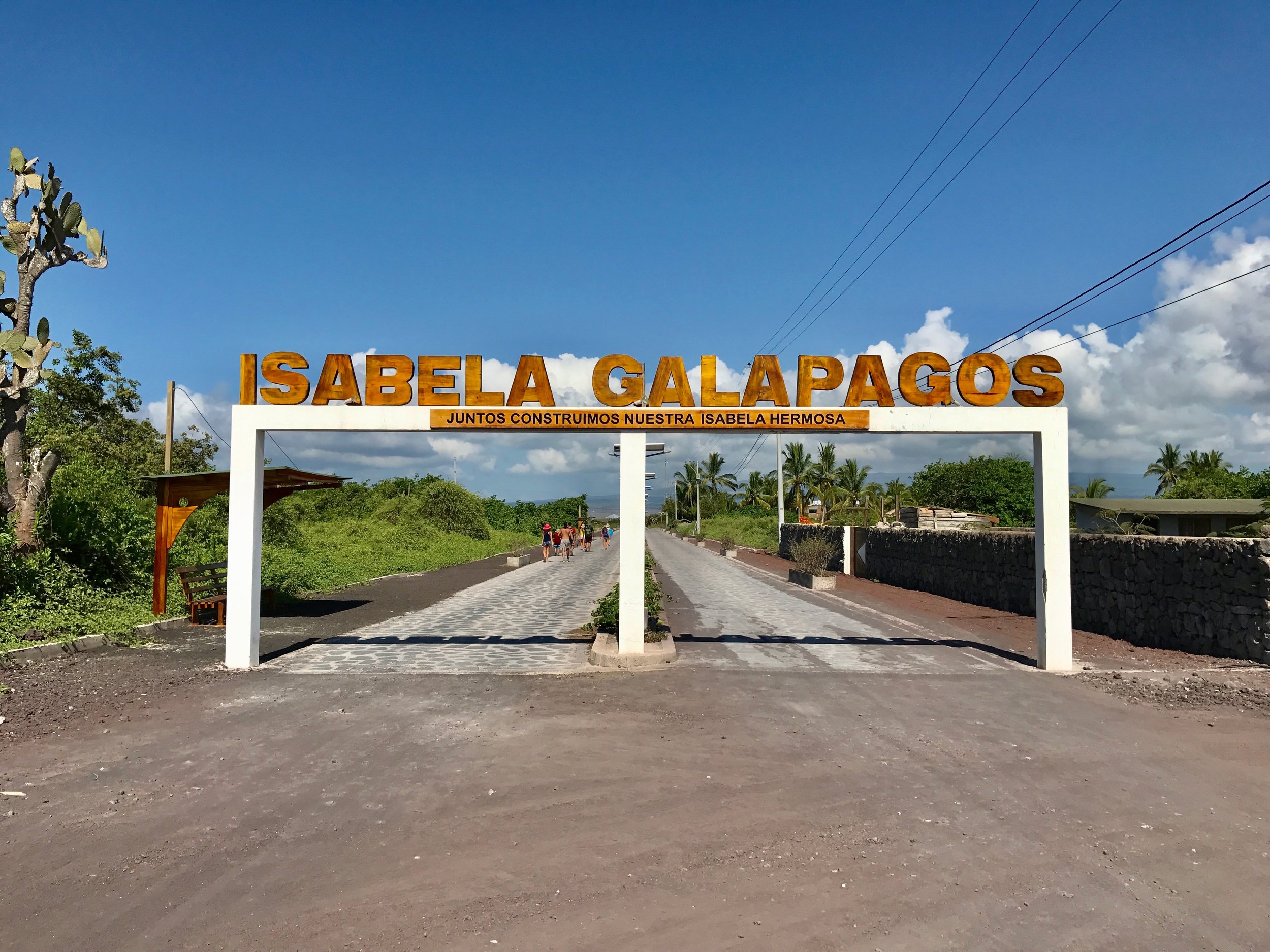Colin is a volunteer who has worked at both the tortoise centre and during the final week of his trip he has volunteered to work with the Galapagos National Park maintenance team. During his free time on Isabela Colin has taken many trips across the island, exploring the land and wildlife whilst documenting his findings with photographs.
ISLAND LIFE and WILDLIFE UPDATE : FEBRUARY
February is a great time to visit Isabela, water temperature is around 25C and thew ildlife is spectacular. From the moment you step foot on Isabela there is plenty to see, on the taxi to the dock this week we saw sea lions climbing onto boats, and the iguanas basking in the tropical sun. This was all before we had even so much as stepped foot onto the wooden jetty.
As February progresses the mercury will rise and although this is one of the rainiest months, the moments of rain are followed by the bright sunshine and blue skies. Due to the rising temperatures the water is warmer and with underwater visibility at an annual high in these months there is a lot of wildlife to be seen both above and below. It is truly like paradise on the island.
February is one of the most active breeding months for many of the indigenous species of birds.Whether you are a bird-lover, underwater fanatic or a land lover, the wildlife is vibrant and the flora and fauna is abundant.
WHAT TO EXPECT IN FEBRUARY?
The Galapagos land Iguana is a common site on Isabela, they can grow to over three feet long. Until the early 2000s, it was believed that the only species to be found on the Galapagos was the yellow/green, then they discovered the pink and black land iguana here on Isabela Island. The land iguanas roam the beaches, one of their nesting sights is cordoned off to protect the species - this shows just how focused the National Park and conservation team are on protecting the species of this paradisiacal island.
Giant Tortoises will begin laying there eggs on the beach - the land giants are unique to the Galapagos. We are lucky enough to have the tortoises here on Isabela one of the few places you can see them. Out of the 15 species globally Isabela is home to many of them.
Similar to the Land Iguana the Marine Iguana is also beginning to nest . The Marine Iguana is the only lizard to split its time between land and sea, nesting season is a great time to spot the Iguana for this reason.
Galapagos Green Sea Turtle spends most of its time in the ocean, during the winter months the females will come ashore to nest and lay there eggs. Students visiting as IOI volunteers to go out every evening to monitor the beach. The same happens in the morning, and a different group walk the 5km of beach to monitor the nesting sights and write down any tracks they have found in the sand. This is an opportunity to see how theGreen Sea Turtle nesting is going and the work is incredibly valuable to help build data about the islands turtle population - the students have found 3 nests in the past two weeks.
The frigate birds are best known for there giant wingspan which can reach close to three yards in length which, in comparison to their body size, gives them the largest proportionate wingspan among all birds species. The males have a large, red throat pouch that inflates during mating to attract the females - during February they are beginning to nest.
The greater flamingo of the Galapagos can grow to be over three feet tall. Their mainly crustacean diet is responsible for their bright pink color. In February the birds are breeding and nesting, but for their own safety they staying larger flocks- you can see the flamingos on the walk to the tortoise conservation.
Galapagos Doves are found only in the Galapagos and the dove’s nesting season reaches its peak during the winter months. The dove is brown in color and will build its nests on the ground; in rock cavities or in the abandoned nests of the GalapagosMockingbird.
February is the perfect time to visit the wildlife haven of the Galapagos, the perfect opportunity to enjoy the verdant green jungle and paradisiacal stretches of beach along the pacific coast. This month the volunteers in Isabela are continuing on their projects with a keen focus on monitoring the turtle’s nesting - this is the first time the project has taken place and is extremely important work for the National Parks. In addition, the volunteers at theTortoise Sanctuary are continuing measuring the young to ensure accurate records are kept. Biweekly beach cleans are being done to make sure the environment and wildlife aren’t affected by the impact of tourism.
February in Isabela is a busy month, but with crystal clear skies and beautiful beaches who can complain?
Georgia B.
Arrival in the Archipelago
London | Spain | Ecuador | Galapagos Islands
The journey to Isabela was long, and albeit the planning complicated, as I flew into Baltra it somehow seemed worth it. Flying over the ocean from Guyaquil I was greeted by the mythological Archipelago of the Galapagos, the azure ocean waves break on the arid rocks. The landscape on Isla Baltra makes you feel as if you are on another planet, the cactus’ growing high in the orange, red sand is a stark contrast to the blue ocean. The animals on these remote islands can’t always be found anywhere else, and the isolated group of volcanic lands are a wonderful showcase of vast ecosystems and biodiversity.
Although the flight might have amassed over 25 hours that is only half the journey (and perhaps on reflection it was the easiest part), upon arrival in Baltra, there’s a bus and boat to Santa Cruz a taxi over the island to the port and then the 2 and a half hour boat trip to the sandy town of Puerto Villamil, on Isabela Island.
Puerto Villamil sits on an island shaped like a seahorse. Formed by an amalgamation of six large volcanoes, one ofmost volcanically active place in the world - a contrast to the otherwise calm and peaceful day to day life on the island.
However remote you may think Isabela is, the population is bigger than we first expected and as I washed up on the shores of the island on my first day, overwhelmed by the accomplishment of getting there, I was aware of just how lucky I am to have the chance to live here for the next few months. I met up withtwo other volunteers Kiki and Sara on the way and we were greeted by Amanda on the dock. No sooner had we stepped of the boat but we found a few Iguanas lying in the sand, basking in the heat - it became quite clear that the animals are free to do as they wish. We were greeted by sandy streets, swaying palm trees, exotic wildlife and incredible people - we quickly realized that this island is pretty much paradise.
A tour of the town and swim in the ocean confirmed we had arrived in a rarely discovered haven and as the warm salty waves lapped on the sand it washed away all thoughts of the journey that had come before.
The volunteer house is next to the IOI building in Puerto Villamil and a short walk into the town, we soon found ourselves sitting in a bustling restaurant on our first night enjoying the island’s buzz, discussing our plans for the trip and all the tours we wanted to do.
From the enormous tortoises, and endemic penguins to lava lizards and a large population of cormorants the inhabitants of this island are remarkable. Among the immense flora and fauna the archipelago is known for being the place where Darwin began to formulate his groundbreaking theories of evolution. The Galapagos Islands are living proof to this theory, the ever-changing landscape, the birth of species and adaptation in these extreme conditions illustrates just that. The islands are filled with hope that, despite the odds being less than favorable on this planet, anything can happen.
As the sunset on our first evening in Isabela we sat on the beach gazing at the clear skies and twinkling stars, breathing in the salty air we all knew that our time in Isabela would be something we won’t ever forget.
Final Blog Rachel Medaugh
In life we face many journeys, so many new paths to travel and chances to discover who we are or who we would like to be. It is not often that we have the chance to face a journey in which we know its exact start and end date, but that’s the exactly what this trip has been for me, it always had a strict end date. A three month journey in which I have tried to explore the whole path, absorb every minuscule detail of the island and hopefully never forget a single moment and grow through out my time here. And no matter how much I never wanted the sun to rise on the final morning of my time here, I knew with all certainty that day would come to pass. I could only hope that I had done all I came to do and could say goodbye to the island with a content heart, and as our boat slowly motored out of Isabela’s harbor I realized I was leaving the island with more than I could ever imagine was possible at first; memories, stories, both good and bad, a new sense of direction in my life, friends to last a life time, and a pretty amazing second language capability. These are just a few of the things my three months in the Galapagos have given me at the end of my journey. In a town of roughly 2,500 people that has no movie theatre, no shopping mall, and no reliable Internet connection many people would be bored out of their minds, that’s what Puerto Villamil sounds like on paper. Luckily for us Puerto Villamil is located in possibly the most beautiful island archipelago in the world, every day there is a new natural experience waiting for any one, the island showed me why it is so important to explore what is right outside your door because you never know how amazing the same place can be every day and how much it can change in a place like Isabela. Not once during three months was I tired of walking the long white sand beach out to el faro and then just sit and watch. Something amazing was bound to happen, or I was going to meet more locals and make more friends. And sometimes I could just go into the waves with my friends and we would just watch the waves crash and talk and talk until we were completely pruned beyond recognition. Many people talk about the “island lifestyle” how its pace is slower and things aren’t ever hurried, I can now see the value behind that, Isabela taught me that things should be enjoyed, that it’s okay to try and do everything but that I must be sure I don’t miss a moment to enjoy just being because I’m too worried about what I need to be doing later. Every hour and every day I had there was very precious and I learned to enjoy them all to the fullest. Studying abroad no matter where you go is an amazing chance and I believe every one should do it, but I can’t imagine there is any other type of study abroad program that can replicate what I experienced on Isabela. Being in such a small town you really become submerged into the culture and family life there, I had over 50 cousins and where ever I went somebody knew me and wanted to talk with me. The atmosphere of open and friendly people is tangible because everybody is curious about who you are and where you come from, and it doesn’t matter if you speak perfect Spanish or not, they will figure out a way to talk with you. The opportunity to have classes in the morning and then walk down the street 5 minutes to actually observe what we discussed in class 30 minutes ago is phenomenal, it gave me the opportunity to have an out of class experience and taught me to apply knowledge to real life observations. Something I consider extremely special that I gained out of this experience as well is 14 new people that I will forever be connected to because of our study abroad experience together; we were there for each other through all the language barriers, the stomach battles, the long hours of class and the amazing sunsets on the beach. I can’t imagine not having been there with out them and I know that as we all move on to our next journeys separately we can still have each other to lean on in times of need, even though the distance may be great.
It takes a Village
A part of my study aboard here in the Galapagos, and possibly the most important part in my opinion, is the cultural exchange that happens every day between myself and the people I have come to know on this island. The classes that we take as students are very intriguing and they take up a fair amount of our time here, but when we go home to our host families we enter a different type of class room. I know that my fellow students and I have had all very different and intriguing learning experiences about the culture here on the island, the topics and knowledge would be all too vast to put down in a simple blog, so instead I’d like to share a bit of my own personal experience.
My little host sister, Julie, she’s the perfect example of a child raised in the town of Puerto Villamil, she doesn’t ware shoes when she runs outside on the hot lava rock gravel, her toys consist of broken Barbie dolls and the baby chicks her family raises to provide eggs and meat for them later down the road. She’s a wild child and at the age of 6 has pretty much free range of the world here. This isn’t to say that Julie is a bad child; she’s pretty much just like any 6 year old in the U.S. stubborn and pushy but also prone to still need your hand to hold when she’s nervous or want a hug when you leave because she will miss you, just as you will miss her. I have never had younger siblings here and as the baby of my own family, just like Julie is, I wasn’t sure how I would deal with having a younger sister. But Julie has shown me another side of family life here on the island that I don’t think I would have noticed with out her help.
Growing up my life was structured and my toys were somewhat new, I had to be very careful and was never left home alone. Here they never lock the door, our home is constantly being filled with neighbors and family members, stopping by and chatting or asking my host mom if she can lend them something, from an iron to a couple of eggs. And Julie, she runs around the house inside and out, playing with the kids that live up and down the street, and she does not know fear. Here on this island things are safer and Julie. Julie can live a childhood with out the fear of what lays beyond the locked front door. That is not to say that there is no crime here, but everybody knows everybody and everybody takes care of the kids, babies are passed around from one person to the next when ever mother visits a store or restaurant, even the waitress wants her turn holding the cute baby. And even though Julie is not constantly under the watchful eye of her parents there is always some one out there looking after the kids because here every one is family.
I can’t say during my childhood I was lucky enough to know what it meant to be raised by a village but here my little sister is, and it makes me unbelievably happy to know that there are still places in this world were children worry less and play more, like my parents did during their life times.
First Impressions
Imagine that you’re starting high school as a freshmen all over again; you don’t know where any of your classes are, your stomach isn’t even sure it can hold down breakfast because the butterflies in your stomach have now become giant wasps bussing around inside you looking for a way out, and you don’t even have a brand new Jamesport backpack to help you make it through, you are just stuck with your old bag from middle school, who knows if you’re gonna make it through the day. That’s what it feels like to fly all the way from Colorado to Guayaquil, Ecuador so that you can live the next three months on a desert island with a whole new family, culture, and language that aren’t your own. I kept myself calm for all of the plane flights by just not thinking about what it was going to be like, I was just going to get there and everything would be fine, or so I hoped.
It is no easy feat to get from Guayaquil to Puerto Villamil, a small port town with a population of 2,800 people on the far west island Isabel in the Galapagos Archipelago, my new home. We took a plane to Baltra Island, hopped a bus to the port, took a boat from the port, with all our luggage precariously perched on the top, to Santa Cruz, and from Santa Cruz we popped onto another boat for two hours to finally arrive in Puerto Villamil. It was at this point when we were moving from the speed boat to the taxi which would take us to the actual dock that I started to feel those wasps in my stomach and it was most definitely not because of the boat ride we just took. What if my Spanish wasn’t up to par? What if my family didn’t like me or didn’t want to spend time with me? Was I doomed to just be a floater in their home never really integrating into the family? That’s what I really wanted; to become apart of their family, to form a connection that would last a lifetime, or at least the next three months I hope.
On the docks I was surprised to learn that the families were actually waiting for us at the IOI facility, I had about 6 minutes to prepare myself, I spent most of it trying to keep the wasps inside my stomach, not out. At the IOI campus there they were, all the parents lined up, sitting under a green tent, calmly waiting, how could they be calm right now? They were about to let complete strangers into their homes, a bunch of college students who may or may not be able to speak Spanish coming into their lives, and they seemed unfazed. All of the students lined up in front of the families and Amanda, the international coordinator for IOI had us play a game to find our family, each student had a paper with an animal name on it and each family who the student belonged to had a matching animal on their own paper, we the students had to make that animals noises and sounds so that our new island parents could find us.
Why did I have to get a horse? Of all the animals that make sounds I cannot imitate a horse, and what was I suppose to do? Gallop around the IOI yard at full canter so my family can see that I’m full on crazy? I still cringe internally a bit at that particular moment. Luckily my family found me before I had to go to such lengths, and suddenly when my dad Freddy and my mom Jenny ran up to me and gave me one of the most memorable hugs of my life, I didn’t feel so worried. They looked at me like a was already some one important to them, Freddy didn’t remove his arms from around my shoulders until we left IOI to go home, I felt like he was trying to make sure I knew I was theirs and that they wanted to make sure I made it home with them.
In my house my little sister Julie ran up and hugged me around the legs, her little 6-year-old arms reaching to their max capacity to get all the way around my legs. She was the best icebreaker for my arrival home; I thought she might be shy with me as some young kids are with strangers, but Julie could never be shy, and her bravery was infectious! When I tried my rusty Spanish out with them for the first time, sitting around the dinning room table it was amazing. They told me I spoke great Spanish and their compliments made me fearless, adding to my efforts to talk with them. We fell into a natural flow of conversation, them occasionally having to decipher what I was trying to explain via my pantomiming of various things, laughing as we went and my hand gestures became sillier and sillier. This new family was definitely going to work out, I could feel it.
I don’t know when it happened exactly, but one by one all 15 of us students have now started to call our host family our true family here; we have to clarify when we are talking about our parents or siblings here on the Island or back in the US. My mom is just my mom here, it’s easier but also she treats me like I am her daughter, making sure I am doing what I need to, even reprimanding me for forgetting to lock my door when I leave the house. Just last night she locked my bedroom door for me, and when I came home panicked that I had forgot to bring my keys with me and that I was locked out, she let me panic for a split second and then told me where the keys were, saying she had locked it to keep Julie my younger sister out and that I must take my keys with me from now on. This may be a small island community but I am not treated like an outsider, the people here are loving and friendly, wanting to talk with you just to learn more about you. I think I have found exactly what I was hoping I would here, a new family and people to have a deep bond with for the rest of my life.
History of ecotourism
Ecotourism has a history that is continuing to grow as more travelers look to travel with an eye on environmental conservation and more countries sustainably incorporate these travelers in their local economies and environments. Although ecotourism has a relatively short history, much has occurred since the term first made its appearance in the dictionary less than 40 years ago.
As long as people have stood on two feet, they have been traveling. Since the dawn of time, people have traveled for reasons relating to war, religion, trade, education, relaxation, leisure, entertainment and more. In the classical world, it was mainly the privileged elite that had the means to travel for amusement or entertainment. Indeed, the Egyptians, Greeks, and Romans all established infrastructure such as roads, seaside resorts, and maps to facilitate travel throughout the ancient world.
With the onset of the industrial revolution, however, traveling or touring became available to the masses. Railroads, improved roads, cars, domestic air travel, and other modes of transportation all made traveling accessible to large amounts of people, and with it the motivations for travel also began to change. As tourism became a formalized industry, people could choose from an assortment of travel options. You could take a day trip to the beach a few miles up the road; you could get in a bus to travel across state lines to take in a ball game or see a relative that had since moved away; or you could jump in an airplane to go on safari in the African jungle.
All these possibilities had not always been available to people living in the world of yesteryear. As people began to take advantage of these exciting and unique opportunities associated with the industrial revolution, the not-so-hidden cost of such opportunities began to become known. Air pollution, deforestation, mass extinction of species, global warming, and sea-level rise have all more-or-less been popularly attributed to the many after-effects of the industrial revolution.
Ecotourism was first conceptualized in the early 1980s as a type of travel for people who wanted to learn about different and exotic environments without causing the environmental harm or damage associated with other forms of tourism. It became an official term in 1982 when it was recorded in the Oxford English Dictionary, and read thusly:
“ecotourism, n. ... Tourism to areas of ecological interest (typically exotic and often threatened natural environments), esp. to support conservation efforts and observe wildlife; spec. access to an endangered environment controlled so as to have the least possible adverse effect.”
Ecotourism gained momentum in the 1990s with environmental conservation and recognizing the planet an exhaustible resource becoming a mainstream consideration. Today, ecotourism continues to grow as more people travel with environmental consciousness. In 2002, the United Nations declared it the year of ecotourism, and in 2003 the Center for Responsible Travel is formed. Since that time, ecotourism has become a $263 billion industry, with a 65% growth rate from 2009 to 2013.
IOI’s passion is to empower isolated communities to grow in a sustainable way through educational travel. Therefor, they take the concept of Ecotourism one step further. Creating stewardship for the environment, they engage with their host communities through educational and social development projects.
Going on an educational adventure with IOI will guarantee you an unforgettable, immersive experience through homestay accommodations and service learning projects and civic engagement. Throughout, the academic component supplements the experience with background in culture, environmental and social aspects of the local community.
By Kevin Bulger, Intern and Guest Blogger
Sierra Negra
Sierra Negra is the most recently active volcano on Isabella Island, making it a great place to finish up our last day of fieldwork for our geology class. The volcano doesn’t have any active flow sites right now, but it does have a very active sulfur mine, an area which is constantly spewing out mass quantities of yellowish gas that smells just like you’d expect it to... day old egg salad that has been sitting out in the sun for too long. I can’t say the prospect of hiking three hours into the rim of a volcano to camp over night with 17 people all with varying degrees of hiking and camping skills, while the constant threat of rain persisted made me jump out of my seat with anticipation. But some times expectations can be wrong, and sometimes they can be so far blown out of the water that you feel ashamed for expecting less of the amazing experience you just had, that’s exactly what happened to me.
The hike up Sierra Negra was un-eventful and bleak, garua, a thick fog common here on the island, persisted as we walked slowly uphill to the rim where we would camp, it was only at the very end of the hike that we popped out of the mist and a whole new land scape materialized into our view. To the left the clouds were hanging low and Cerro Azul, another volcano on island, was peaking out at us with the ocean along side it, and to the right the caldera of Sierra Negra with it’s sinuous ridge, a large knife ridge on the left side of the caldera caused by an interesting geological occurrence of the ground shifting in two different ways, shot up from the ground. The view was stunning to say the least, and were would get the chance to watch as the sunset on all this glorious landscape.
I thought that there was no way that the view could get better that night, especially as the sunset turned from bright oranges and reds to smoky purples and blues with Jupiter shinning out as the last rays of light left the land, but once again my expectations were wrong. The night ski came out to play and I remembered again what it was like to camp out where there was no light pollution to obscure the lights of the stars and the Milky Way. Some times there are no words to really describe what one felt and saw in those special moments in life when wonders occur, that night was one of them, the best I can do is leave you with a photo of that moment and hope you feel some of the magic we all did that night.
What is ailing the Galapaguenos?
Before arriving in Isabela I had a very remote idea of what would be waiting for me. When I mentioned to friends in the United States that I was going to the Galapagos Islands for nearly three months to do public health work I was often met with utter confusion, as many do not realize that there is a substantial human population in the Galapagos.
Of course everyone has heard of the wonders of the Galapagos Islands with its nature and diverse wildlife and as the birthplace of Darwin’s Theory of Natural Selection. However, little is spoken of the people that actually live here. Truthfully, before planning my trip I had trouble finding the Galapagos Islands on a map. I was ignorant to the culture of the people here and even the language that was spoken. To my delight I found that the Galapagos Islands are an Ecuadorian province made up of Spanish-speaking families who have either migrated here from the Ecuadorian mainland or who have lived here for many years. Having been born and raised in Miami, a city that hosts many different Latin cultures I was comforted to know that I would be able to communicate with the locals and be familiar with many of their customs. Isabela is less inhabited than some of the more commercial islands and has more of a small town feel. It is breathtakingly beautiful with its beaches and unique animals but at the same time is immensely in need of public health improvements.
There are many health concerns on the island as I was informed of when I arrived. The project that I will be focusing on during my time here is nutritional education for the local population on a multitude of levels. Metabolic disorders like obesity, diabetes and heart disease are common in Isabela, due to the lack of ample nutrition in the local population’s diets. Since the population at one point in time was malnourished, currently more weight is placed on eating larger meals with artificial supplements rather than on maintaining a well-balanced diet. Therefore, my current project includes developing and holding nutrition workshops for parents, school care workers and pregnant teenagers within the community. I am also developing new meal plans for the children within the schools as many of the schools provide daily meals for the children. I am hoping that by working jointly with the parents, teachers and cooks through education, cooking workshops and meal plans they will be empowered to change their eating habits for the long term. So far I have had a great response from the people here, they have been incredibly welcoming and are so open minded and eager to learn about things they can do to improve their health.
Another exciting project that I worked on during my time with IOI was on developing a community health assessment of prevalent diseases within the community. This was done by working in the local hospital with their health records in order to assess what diseases needed more attention. Respiratory infections and diarrheal infections were the most common health problems found on the island of Isabela, with a prevalence of 20.6% and 3.19% respectively over an 8 month period. This is likely due to poor hygiene and inadequate water sanitation. Among chronic diseases, high blood pressure (2.35% prevalence) and diabetes (0.80% prevalence) were present among individuals. Hopefully, the findings from the community health assessment will facilitate the planning and implementation of the community health center that IOI is preparing to open in the future. My time in Isabela so far has been incredible. I feel so lucky to have worked with an organization that cares so much about making a difference in the lives of those within the local community. After I leave in August I will go back to Boston University to finish my Master of Public Health degree in Epidemiology and really hope to continue to work on outreach projects similar to those completed in Isabela!
Jessica B. – public health
International Coastal Clean-up Day
Last Saturday was international coastal clean up day and we at ioi contributed by participating in the coastal clean up sponsored by the Galapagos National Park. Every one has their own personal volunteer project but on this day we all came together to help a worthy cause, especially here in the islands where keeping the land as clean as possible not only benefits the terrestrial animals but also helps keep the ocean clean, one of the most beautiful aspects of the archipelago. I can’t say that being dropped off on a dirt road at 8 am to pick up various pieces of trash is my ideal Saturday morning; in fact my ideal morning on a Saturday involves a lot more sleep and a lot more coffee than the meager half cup I was able to put down before we had to run off to start the clean up, but this morning was most definitely one to remember.
Despite my under-caffeinated state this clean really got me think about what kinds of impacts people can have on the environment and why the government of Ecuador has so many regulations to try and keep the islands as pristine as possible. Their immigration policies to the islands makes it almost impossible for new comers to move to the islands, you have to be born here or marry some one who is in order to become a legal resident, and after seeing the trash that had accumulated on the side of the road, I understood their reasoning a little better. I don’t think I truly realized the kind of impact people could have on the natural environment in a place like theGalapagos, where the people live side by side with some of the most effective and strict conservation regulations the world over.
The locals understand and respect all of the regulations, but no place is perfect and humans naturally produce trash in mass quantities. I have to commend the park for recognizing this issue and doing it’s best to deal with the issue hosting clean up days and encouraging recycling and respect for the environment in the community. The city also works hard to keep waste to a minimum here as well, each house has four different trash cans in front where they put all the various sorted garbage so as to produce as little waste as possible. Even with just 2,800 people as permanent residents it’s hard to keep their impact here to the bare minimum, but the community is doing it’s best and its possible to see that any where you go, from the fact you have to have a tour guide if you ever travel national park land or that the only 3% of the land will ever be allowed to be built upon, the other 97% a permanent national park and UNESCO world heritage site. This marriage between people and land is truly something special to witness and I hope one day the rest of the world can adopt the same environmental husbandry techniques they use here to protect this unique ecosystem.





























